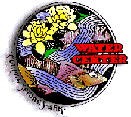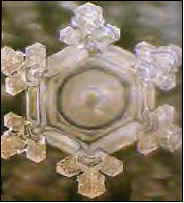
National Water Center, Eureka Springs, Arkansas

National Water Center, Eureka Springs, AR
Updated: April 2014 Contact: Contact: NWC
Contents ©1999-2014 by National Water Center. All rights reserved worldwide.
The photos below are from the referenced book which describes the author's experiments with frozen water crystals taken from both natural and chemically-treated or polluted water sources. Showing the crystalline patterns in frozen water give a message as to the water's basic structure and symmetry. Clean and pure water, from natural and unpolluted sources, show brilliant and sparkling snowflake patterns, rich in color and luminosity. By contrast, water from chemically-treated sources, or polluted waters, shows flat and dull patterns,
lacking in structure or color. The water crystals also respond to human activity and to music. One can
immediately see which water is more alive and life-enhancing, and which is not, thereby bridging the gap between subjective and objective measures.
EXPOSED TO HEAVY METAL MUSIC
THANK YOU IN JAPANESE
THE MESSAGE FROM WATER - Telling Us to Take A Look At Ourselves by Masaru Emoto 145 pp., in both Japanese and English text, with color photos on nearly every page. $ 30.00, Soft Cover, Import Order from: Natural Energy Works, PO Box 1148, Ashland, Oregon 97520 USA tel/fax: 541-552-0118 - demeo@mind.net.
PKI INTERNATIONAL – THINKING LIKE A MOUNTAIN INSTITUTE.
WaterWorks Update is published periodically throughout the year. Contributions are solicited and welcome. Please send to WaterWorks Update, PO Box 210, Hackett, AR 72937 or pkitlami@aol.com. Subscriptions are available for $25 per year, which includes a copy of our annual comprehensive volume. In 2001 this will focus on Water and Watersheds.
Experts Warn that Earth’s Water Supply is Rapidly Dwindling
US Water News Online, September 2000
www.uswaternews.org
STOCKHOLM, Sweden -- Experts at an international water conference warned that demand from a fast growing world population was reducing rivers to a trickle and threatening agriculture. ``Water scarcity is probably the most underestimated emerging issue today,'' Worldwatch Institute President Lester Brown told more than 800 delegates in his opening address at the 10th annual Stockholm Water Symposium. Brown called for a push in water conservation efforts comparable to land conservation efforts earlier this century.
``Water has been an abundant resources and an essentially free resource so we take it for granted,'' he said. ``We now know we can't do that anymore.'' The head of the Washington-based research group pointed to aquifer depletion and drained rivers as the main problems facing future generations and said the world could not afford to ignore the symptoms. He cited the Colorado River in the United States, the Nile River in Africa, and the Ganges River in South Asia as among those that often run dry before they reach the sea.
He also warned of political instability, saying minor rioting had broken out in China when the government tried to fix leakage in a dam along the Yellow River to channel the water to the interior. The leakage was being used by farmers in the east coast province of Shandong.
``It's a case study in the competition that develops when water runs low,'' Brown said.
Commencing in 2001 PKI and WaterWorks will focus on watersheds. A volume on this topic will be produced and WW Updates will focus on this theme.
Everyone lives in a particular watershed which is defined by its own unique natural features including hills or mountains, water ways, and living things, both plant and animal. Bioregionalism has the potential to offer hope for taking care of our world. By learning about our watershed within our bioregion we reconnect with the natural world.
Once we become reconnected we become part of something powerful. Becoming an integral part of our surroundings, rather than dominating them, allows us to appreciate more deeply our home (the planet) and will allow us to travel through the next millennium with a realization that we must live that is suitable for everyone.
Through out the next year in these pages we will celebrate those who have reconnected to their “place” in our natural world. Having a watershed-bioregional awareness provides for a healthier and environmentally sensitive way of life.
inside
Page 2 - WaterWords
The World’s Water
Page 3 - The Message from Water
Calling the Rain Spirit
Page 2
COMMENTARY
WaterWords
Book Review
The World’s Water
Water Haves and Have-nots – the increasing disparity of water quality.
Recently I received a catalog advertising a variety of “natural” products and earth friendly “must haves” for all environmental correct citizenry.
I admit the products were practical, made sense (such as reusable coffee filters), and provided many alternatives to our throw away system.
Then I came across a lengthy section on water filtration devices to ensure that water coming from the tap could be free from any impurity. Products ranged in price from a few to hundreds of dollars.
I was impressed by this array of technology available to ensure a safe water supply for the home. However, I was soon becoming concerned that this was another example of the disparity in our world. Those wealthy enough to afford such devices have no concern about efforts to upgrade public water systems to meet safer standards.
A fear is that as we hear of more problems with water supplies that those who can afford in home water purification systems will obtain them. Will public water supplies continue to decline as less public funds are expended to maintain and upgrade water supplies?
ROBERT McAFEE
 The World’s Water 2000 – 2001. The Biennial Report on Freshwater Resources
The World’s Water 2000 – 2001. The Biennial Report on Freshwater Resources
by Peter H. Gleick. Island Press. Washington, DC.
www.islandpress.org
HALF THE WORLD’S POPULATION DOES NOT HAVE ACCESS TO CLEAN OR SAFE WATER! The world’s population continues to grow and with this an increasing demand for water. While there are many issues that must be addressed . . . few are as fundamental as those that surround human needs and uses of water . . .
In this, the second in his series, Peter Gleick, tracks the state of the world’s water, the debate surrounding its use and distribution, and the technology being utilized or being promised to bring water to the world’s people.
Covered in this volume: Water as a Basic Human Right; Who Owns the Water; Alternative Methods for Obtaining Clean Water; Water and Food; Dams; and, The Future of Water.
Without doubt The World’s Water is the most comprehensive and current inventory and analysis of the water resources of the planet and the political, economic, scientific, and technological issues associated with them.
Anyone concerned with water and water issues at whatever level or expertise cannot afford to be without this truly remarkable and valuable resource.
Page 3
The Message from Water
My daughter and I once drove past a spot where trees and grass were on fire. We stopped: 100 degrees, no clouds, nothing to fight the fire with. Rain Drop was 5 then. She said she would call the Rain Spirit and she did.
Eyes closed she sat there in the back seat, legs crossed and then she fell right over. She laid totally still. Little Wind and I watched, not sure what to do.
A few minutes and she sat up. A few more and the rain came in sheets so heavy cars pulled over and stopped. The fire was put out at once. I saw it happen. It was child’s play.
I do not expect you to believe it; I only tell you this because I saw the price we have paid in trading trust for reason.
Rain Drop knew exactly what to do and she did it. I saw it.
I do not expect you to believe it.
From: The Sioux Dog Dance: shunk ah weh. Poems by Red Hawk ‘Hawk Fecit”. © 1991 Red Hawk. Cleveland State University Poetry Center.



Calling the Rain Spirit
Water & Watersheds
In the News